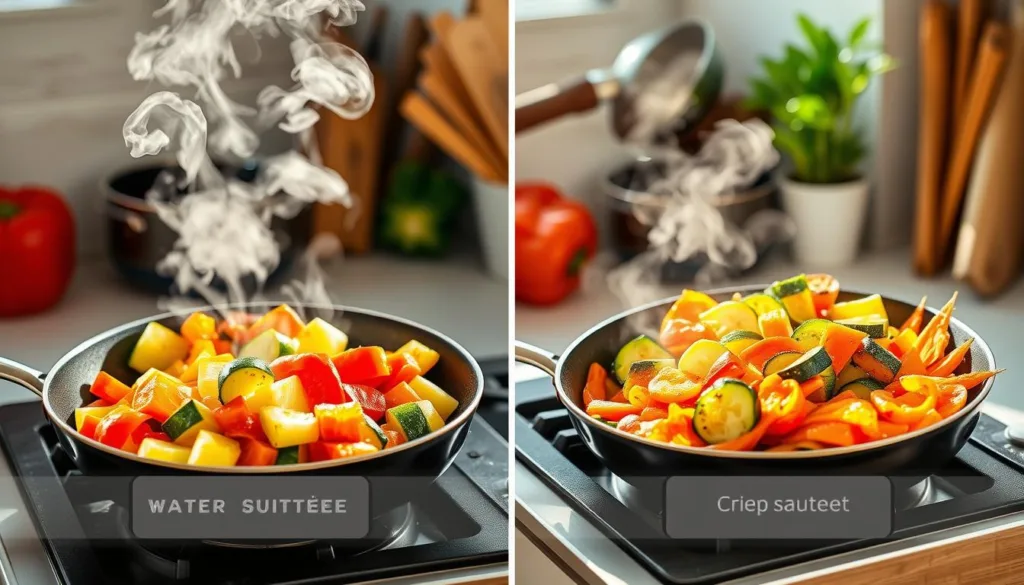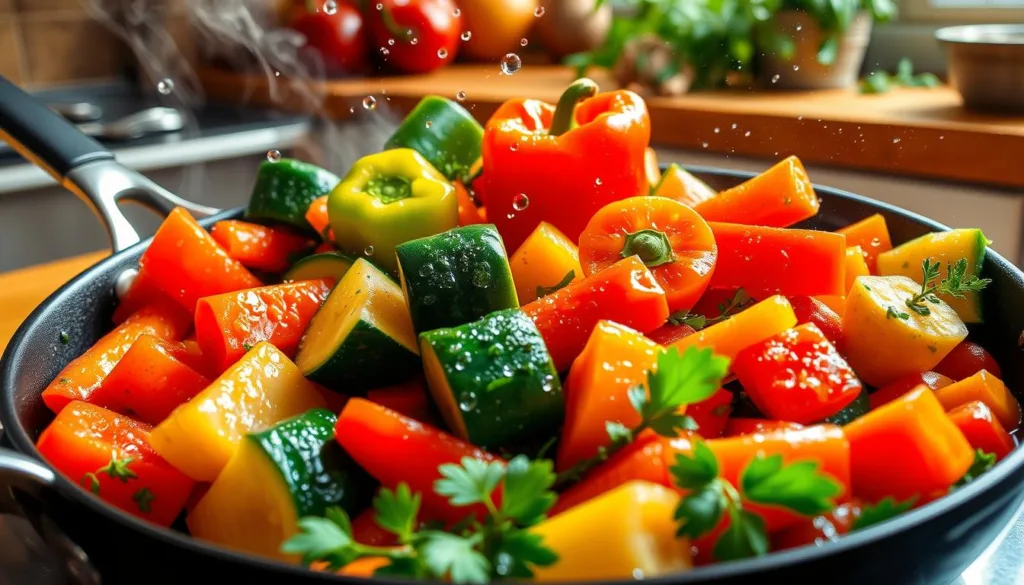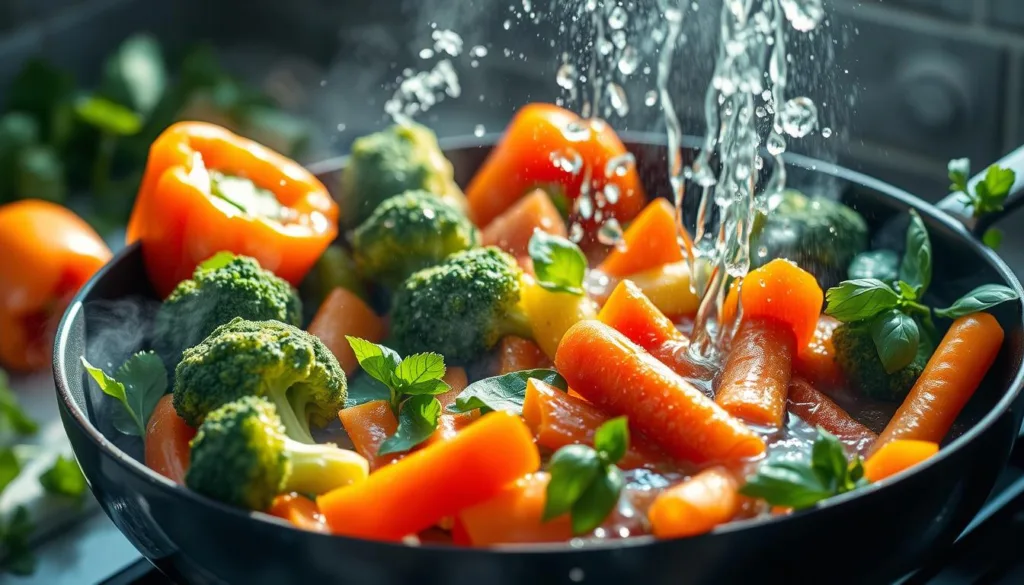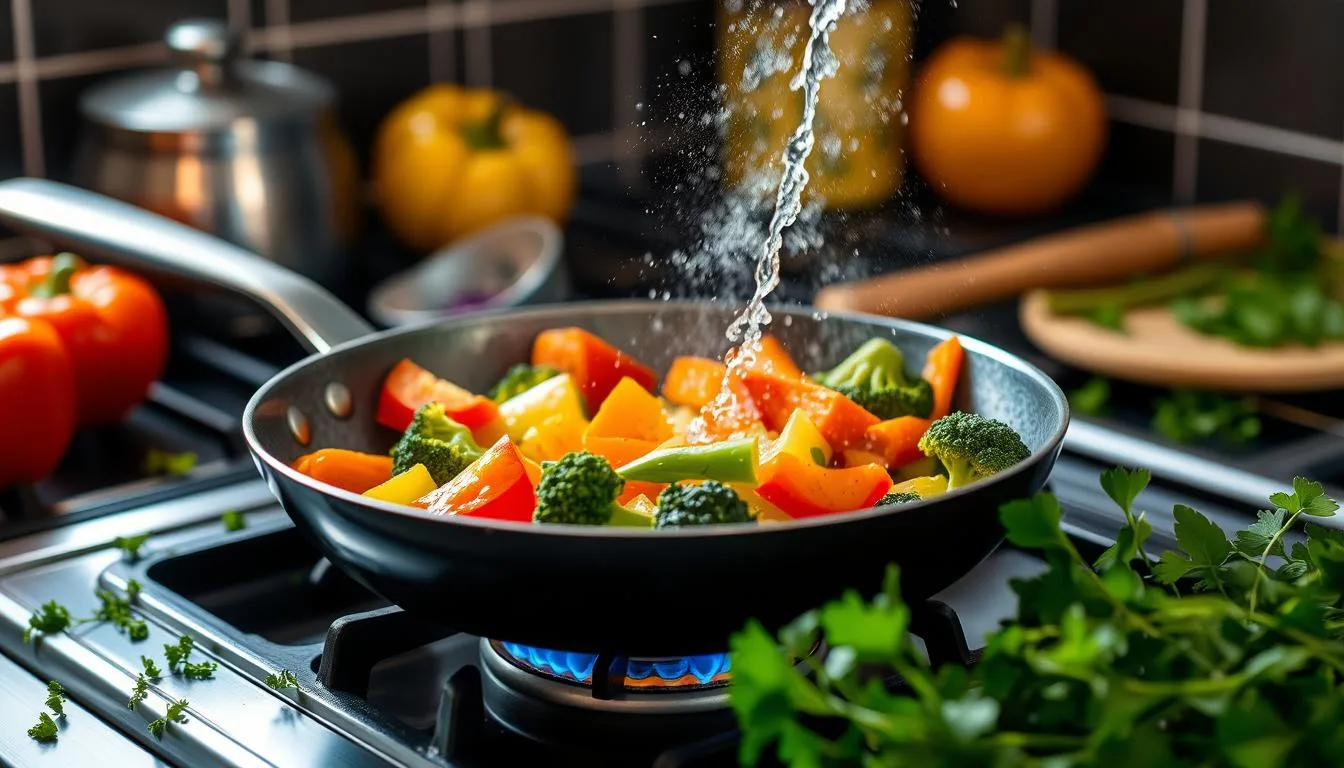how to use water to sauté vegetables ? Ever looked at a skillet and wondered how to make veggies like a pro without too much oil? Water might be your secret ingredient. Water sautéing is a new way to cook veggies that’s changing how we prepare them at home .
Think about making veggies that are both tender and crisp, with bright colors and deep flavors. This method uses water to steam and brown veggies at the same time. Learning to sauté with water opens up a whole new world of healthy cooking.
Key Takeaways
- Water sautéing reduces fat content in cooking
- Technique preserves vegetable nutrients and color
- Works best with various vegetable types
- Simplifies cooking process compared to traditional methods
- Creates restaurant-quality results at home
- Enables precise texture control
Understanding the Water-Sautéing Revolution
Cooking fans are finding a new way to sauté veggies that changes the game. This method, called oil-free sautéing, is a big nutritional win. It shakes up cooking habits that have lasted for decades.
The water-sautéing method is a bold new choice over old oil-based cooking. It lets you make tasty meals with fewer calories and more nutrients. This is a big deal for anyone looking to eat better.
The Science Behind Water-Based Sautéing
Water-based sautéing uses a smart three-step process:
- First, veggies get browned.
- Then, water is added for a gentle steam.
- Finally, the water evaporates to caramelize the veggies.
Benefits of Using Water Instead of Oil
No-fat sautéing brings big benefits:
- It cuts down on inflammatory compounds from heated oils.
- It keeps more nutrients in veggies.
- It also means fewer calories.
“Water sautéing maximizes nutritional value while minimizing health risks” – Culinary Nutrition Expert
Why Traditional Sautéing Methods Fall Short
Old oil-based methods often lead to:
- Blackened veggie outsides.
- Undercooked insides.
- Too much fat.
Switching to water-sautéing opens up a healthier, more precise cooking way. It makes sure your veggies are cooked just right every time.
Essential Equipment for Perfect Water Sautéing
Mastering water sautéing is more than just cooking skills. The right tools can make your steam-fry veggies amazing. Let’s look at the key equipment that will improve your cooking.
Choosing the Right Pan Material and Size
A 12-inch skillet is perfect for water sautéing. Stainless steel or cast iron pans are best for heat and durability. When picking a pan, remember these important points:
- Even heat distribution
- Depth of at least 2-3 inches
- Heavy-bottom construction
- Tight-fitting lid
Important Pan Features for Water Sautéing
Not all pans are the same. For great water sautéing, look for these key features:
| Feature | Importance |
|---|---|
| Straight Sides | Prevents liquid spillage |
| Comfortable Handle | Reduces hand fatigue |
| Non-Reactive Surface | Prevents flavor contamination |
Additional Tools and Accessories
Enhance your water sautéing setup with these useful accessories:
- Wooden spatula for stirring
- Kitchen tongs
- Measuring cups for precise water addition
- Vegetable chopper for consistent cuts
Pro tip: Invest in quality cookware. A great pan is the foundation of exceptional water sautéing.
With the right equipment, you’ll be ready to make perfectly steam-fried veggies. They’ll be both healthy and tasty.
How to Use Water to Sauté Vegetables
Learning to sauté vegetables with water can change your cooking game. This method cuts down on oil use while keeping flavors and nutrients intact. It’s easy to learn, making it great for cooks of all levels.
The water sautéing process has three key steps:
- Initial Browning: Start by heating your 12-inch skillet and adding veggies for spotty browning
- Water Steaming: Add a bit of water to steam and keep cooking
- Final Browning: Remove excess moisture for more caramelization
“Cooking vegetables without oil doesn’t mean sacrificing flavor – it means discovering a healthier cooking approach.”
Each vegetable needs its own water sauté tips. Broccoli and green beans work well, but zucchini might need a different approach.
| Vegetable Type | Water Sauté Approach | Cooking Time |
|---|---|---|
| Broccoli | Initial browning, then steam | 5-7 minutes |
| Mushrooms | Start with water to release moisture | 4-6 minutes |
| Baby Bok Choy | Crisp stems, wilted leaves | 3-5 minutes |
Don’t overcrowd your pan and flip veggies every minute for even cooking. With practice, you’ll sauté veggies perfectly in under 10 minutes.
Common Mistakes to Avoid When Water Sautéing
Water sautéing is a delicate cooking technique that needs precision and care. To master it, you must know the pitfalls that can ruin your vegetable prep.

Temperature Control Challenges
When cooking veggies without oil, controlling the temperature is key. Chefs often make these mistakes:
- Starting with a pan that’s too cold, preventing proper vegetable caramelization
- Overheating the pan, which can quickly burn delicate vegetables
- Not preheating the pan to the correct temperature for water sautéing
Timing and Water Management Errors
Getting the right amount of water is crucial in water sauté technique. Avoid these common mistakes:
- Adding too much water, which turns sautéing into steaming
- Not adding water at the right intervals
- Using water inconsistently across different vegetable types
“The secret to perfect water sautéing is understanding your ingredients and controlling moisture.”
Vegetable Preparation Pitfalls
Successful water sautéing starts before the pan heats up. Make sure to cut vegetables evenly and prepare them right for the best results:
- Cutting vegetables into inconsistent sizes
- Overcrowding the pan, which prevents proper cooking
- Not patting vegetables dry before sautéing
By avoiding these common mistakes, you’ll improve your water sautéing skills. You’ll make delicious, perfectly cooked veggies every time.
Best Vegetables for Water Sautéing Technique
Mastering the water sauté technique is all about picking the right vegetables. Not every vegetable cooks the same way with this method. So, choosing the right ones is key to getting great results.
Vegetables react differently to water sautéing. Some release moisture easily, while others need careful handling of liquid.
- Leafy Greens: Spinach, kale, Swiss chard
- Crisp Vegetables: Broccoli, asparagus, green beans
- Tender Vegetables: Zucchini, mushrooms, bell peppers
Mushrooms are a standout in water sautéing. They release their own moisture and don’t need much water. They turn golden brown in about 5 minutes. This makes them perfect for this cooking method.
| Vegetable Type | Water Sauté Characteristics | Recommended Cooking Time |
|---|---|---|
| Shiitake Mushrooms | Self-liquefying, quick browning | 5-7 minutes |
| Swiss Chard | Tender stems, wilting leaves | 7 minutes |
| Asparagus | Crisp texture, quick cooking | 4-6 minutes |
“The secret to perfect water sautéing lies in understanding each vegetable’s unique cooking profile.” – Culinary Expert
When you’re sautéing vegetables, remember the importance of water. Start with about 2 tablespoons of water and add more as needed. Stir every two minutes to get even browning and prevent sticking.
Step-by-Step Water Sautéing Process
Learning to sauté vegetables with water is a game-changer. It’s a healthier way to cook than using oil. You can make tasty, nutritious dishes easily.

Initial Browning Phase
Start by heating a good pan over medium-high heat. Choose a pan with a thick bottom for even heat. Put your chopped veggies in the dry pan to get a golden-brown color without oil.
- Use a non-stick or cast-iron skillet
- Ensure pan is preheated before adding vegetables
- Stir vegetables occasionally to prevent burning
Water Addition and Steaming
When veggies start to brown, add a bit of water. This creates a steamy environment. Cover the pan to keep moisture in and cook veggies fast. This method is great for dense veggies like carrots and broccoli.
“Water sautéing is about understanding heat, moisture, and vegetable characteristics” – Culinary Expert
Final Cooking and Seasoning
After steaming, take off the lid and let water evaporate. This step makes flavors richer and textures perfect. Add your favorite herbs or spices in the last minutes to boost flavor.
- Cook times vary by vegetable type
- Leafy greens need only 1-2 minutes
- Denser vegetables require 8-10 minutes
- Season just before removing from heat
By following these steps, you’ll make veggies that taste like they’re from a restaurant. They’re healthy and delicious.
Tips for Achieving Perfect Texture and Flavor
Learning water sauté tips can make your veggie cooking amazing. Cooking without oil needs precision and knowing key techniques. These skills can boost your cooking abilities.
Temperature control is key in water sautéing. Start with high heat for browning, then lower to medium-high for the best texture. Each veggie cooks differently:
- Leafy greens like spinach need just 2-4 minutes
- Hearty veggies like broccoli take up to 10 minutes
- Softer veggies like zucchini cook well in 4-6 minutes
“The secret to perfect water sautéing lies in understanding each vegetable’s unique cooking characteristics.”
Seasoning is crucial for flavor. Pro tip: Add dried herbs and spices in the last 30 seconds. This boosts taste without harming texture. Use salt sparingly at the end to keep moisture in.
Choose a non-stick skillet for the best results. Use 2-4 tablespoons of water for harder veggies. This steaming effect ensures even cooking. Stir veggies just once or twice to get perfect browning.
Quick Cooking Time Guide
- Frozen peas: 2 minutes
- Mushrooms: 7 minutes
- Bell peppers: 10-12 minutes
- Carrots: 12 minutes
Cutting veggies evenly helps them cook the same. By following these water sauté tips, you’ll make veggies that taste great and are healthy.
Adapting the Technique for Different Vegetable Types
The water sauté technique is very flexible. But, you need to know how different veggies react to cooking. The way you cook veggies changes based on their texture, water content, and density.

Leafy Greens and Tender Vegetables
Leafy greens like spinach and kale need a gentle touch. They cook fast and can get mushy if cooked too long. Start with a hot pan and add just enough water to make steam. Cook for 2-3 minutes, stirring often to stop them from wilting.
- Spinach: 1-2 minutes cooking time
- Kale: 3-4 minutes cooking time
- Swiss chard: 2-3 minutes cooking time
Root Vegetables and Dense Produce
Root veggies like carrots and parsnips need a different method. They take longer to cook and need more water to soften. Cut them into small pieces to cook evenly.
| Vegetable | Cooking Time | Water Quantity |
|---|---|---|
| Carrots | 4-5 minutes | 2-3 tablespoons |
| Parsnips | 5-6 minutes | 3-4 tablespoons |
| Turnips | 3-4 minutes | 2 tablespoons |
High-Water Content Vegetables
Vegetables like zucchini and tomatoes are already moist. When water sautéing them, use little extra water to avoid them getting too wet. Cook them quickly at high heat, adding water now and then.
“Mastering water sauté technique is about understanding each vegetable’s unique characteristics.” – Culinary Expert
By adjusting your water sauté method for each veggie, you’ll make dishes that are both tasty and perfectly cooked every time.
Health Benefits and Nutritional Advantages
Water sautéing is a new way to cook veggies that keeps them full of nutrients. It’s a method that doesn’t use oil. This makes it great for your health and how well your body absorbs nutrients.
Nutrition experts have found many benefits in water-based cooking:
- It keeps more vitamins and minerals than cooking with oil
- It cuts down on calories without losing flavor
- It helps keep important nutrients in the veggies
Studies show water sautéing has big nutritional benefits. A 2009 study found that some cooking methods can really change how much nutrients are in veggies. Microwaving with a little water can boost nutrients in veggies like zucchini, carrots, and beans by up to 30%.
“Cooking veggies smartly can make nutrients easier to absorb by breaking down tough cells” – Nutrition Research Institute
Using water sautéing as your main cooking method brings many health perks:
- It makes nutrients more available to your body
- It helps your body absorb minerals better
- It cuts down on calories
- It keeps more nutrients in the veggies
Also, cooking methods like water sautéing can make antioxidants easier to get. For example, cooked spinach and carrots have more beta carotene in your blood than raw ones. This helps your health and might even prevent diseases.
Conclusion
Learning how to use water to sauté vegetables has opened a new world in cooking. This method is great for keeping nutrients in your veggies while making them taste amazing. It’s a healthy way to cook that changes the game.
Using water to sauté means you cook with less fat and keep more nutrients in your food. This way, your veggies stay colorful, crunchy, and full of goodness. It makes your meals look good and feel good for you.
As you get better at water sautéing, you’ll love how easy and effective it is. It works for all kinds of veggies, from soft greens to thick roots. It lets you be creative in the kitchen while staying healthy.
Your kitchen is now ready for a big change. Water sautéing is not just a cooking trick. It’s a way to eat better, enjoy more flavors, and appreciate the natural taste of fresh veggies.
FAQ
What exactly is water sautéing?
Water sautéing is a cooking method that uses water instead of oil. It’s a healthier way to cook vegetables. You get similar results to sautéing with oil but with less fat and calories.
Is water sautéing really as effective as traditional oil sautéing?
Yes, water sautéing can be just as good as oil sautéing. It makes vegetables taste great and look nice without extra fat. You just need to control the heat and know how long to cook the veggies.
What type of pan works best for water sautéing?
Use a heavy, non-stick pan with a tight lid for water sautéing. Stainless steel or cast iron pans are best. The pan should be big enough for veggies to cook in one layer.
How much water should I use when water sautéing?
Start with 2-4 tablespoons of water for most veggies. Add more as needed. You want steam to cook the veggies without making them soggy.
Can I use this method for all types of vegetables?
Most veggies work well with water sautéing, but some better than others. Harder veggies like carrots take longer, while soft ones like spinach cook fast. Adjust cooking time based on the veggie’s type and water content.
What are the main health benefits of water sautéing?
Water sautéing is healthier because it cuts down on calories and preserves nutrients. It also avoids extra fats. This way, you can enjoy tasty meals without the extra fat.
How do I prevent vegetables from sticking when water sautéing?
Use a non-stick pan and start with a little water. Keep the heat high and stir often. If veggies stick, add more water and lower the heat a bit. A seasoned cast iron or non-stick pan helps prevent sticking.
Can I add seasonings during water sautéing?
Yes! You can add herbs, spices, and aromatics while cooking. Garlic, onions, and dried herbs go in at the start. Add fresh herbs towards the end to keep their flavor and color.
Looking for more delicious recipes to try? Explore these amazing dishes on American Tasty:
- Red Lentil Soup with Warm Spices: A comforting, flavorful soup perfect for any season.
- Fishcakes and Scallops Stir-Fry Recipe: A quick and easy seafood dish with a savory twist.
- Chocolate Espresso Dacquoise: A decadent dessert that combines chocolate and coffee flavors.
- Crab Dip: A creamy, crowd-pleasing appetizer for any gathering.
- Pea Salad: A fresh, vibrant side dish that’s perfect for summer meals.
- Breakfast Lasagna: Start your day with a hearty and unique breakfast recipe.
- Pumpkin Soup: A rich, velvety soup that’s ideal for autumn evenings.
Join Our Community!
💬 Facebook: Stay updated with our latest recipes, cooking tips, and delicious inspiration. Join the conversation and share your creations with us on American Tasty’s Facebook page.
📌 Pinterest: Discover mouthwatering recipe ideas and save them for later! Follow our boards on American Tasty’s Pinterest for endless culinary inspiration.
✨ Why Join?
- Get exclusive recipes and updates.
- Share your food creations and inspire others.
- Connect with a community of food lovers like you!

